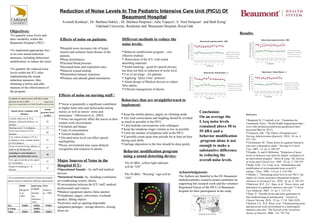
Poster- PICU Noise Study-April 2012
- 1. Reduction of Noise Levels In The Pediatric Intensive Care Unit (PICU) Of Beaumont Hospital Avinash Konkani1, Dr. Barbara Oakley1, Dr. Barbara Penprase1, Julie Topacio2, S. Noel Simpson2 and Beth Kring2 1 Oakland University, Rochester and 2Beaumont Hospital, Royal Oak Objectives: •To quantify noise levels and Results: their variability within the Effects of noise on patients: Different methods to reduce the Beaumont Hospital’s PICU. noise levels: Hospital noise increases risk of hyper •To implement appropriate low- tension and ischemic heart disease in the Behavior modification program – cost or no-cost sound reduction patients. effective method measures, including behavioral Sleep disturbances Renovation of the ICU with sound modification, to reduce the noise. Elevated blood pressure absorbing materials Increased heart and respiration rates Sound masking – good for speech privacy •To quantify the reduced noise Delayed wound healing but does not help in reduction of noise level. levels within the ICU after Use of ear plugs – for patients Diminished immune responses implementing the sound Applying “Quiet Time” protocol Pituitary and adrenal gland stimulation reduction measures, thus Alarm design of Medical devices to reduce obtaining a before and after false alarms measure of the effectiveness of Efficient management of alarms the program. Effects of noise on nursing staff : Example of sound sources with their sound pressure levels in dBA. Adapted from Behaviors that are straightforward to (http://www.sengpielaudio.com/TableOfSoundPressureLevels.htm “Noise is potentially a significant contributor implement: ) Sound to higher heart rates and tachycardia among Sound source examples with distance pressure level nurses, as well as nurses’ stress and Keep the mobile phones, pagers on vibrating mode Conclusion: in dBA annoyance.” (Morrison et al., 2003) References: 2-stroke chain-saw at 10 m Noise can negatively affect the nurses in their Any loud conversation and laughing should be avoided On an average the Berglund, B, T Lindvall, et al., “Guidelines for distance, loud toilet flush at 1 m 85 routine work environment: as much as possible in the PICU LAeq noise levels Community Noise.” World Health Organization http:// distance Irritation and fatigue Limit bedside conversations with colleagues remained above 50 to www.who.int/docstore/peh/noise/guidelines2.html Passing car at 7.5 m distance 75 Lack of concentration Keep the telephone ringer volume as low as possible (accessed Mar/16/ 2011). Noisy lawn mower at 10 m 60 Limit the number of telephone calls in the PICU 55 dBA and a Choiniere, DB. “The Effects of hospital noise.” distance Tension headaches Low volume of radio or TV at 1 Elevated noise level can affect speech If possible create quiet time periods for at least an hour behavior modification Nursing Administration Quarterly 2010; 34, no. 4: 327–333. m distance, noisy vacuum cleaner at 10 m distance 55 intelligibility during each shifts. program alone is not Christensen, M. “Noise levels in a general intensive Garbage deposition in the bins should be done gently Noise of normal living; talking, or 45 Noisy environment may cause delayed enough to make a care unit: a descriptive study.” Nursing in Critical recognition and response to alarms. Care 2007; 12, no. 4: 188-197. radio in the background Behavior modification program substantive difference Elander, G, and G Hellström. “Reduction of noise Learning or concentration is possible, but distraction occurs. 40 using a sound detecting device: in reducing the levels in intensive care units for infants: evaluation of an intervention program.” Heart & Lung: The Journal Very quiet room fan at low speed 35 Major Sources of Noise in the overall noise levels. of Acute and Critical Care 1995; 24, no. 5: 376-379. at 1 m distance At 45 dBA- yellow light indicator Sound of breathing at 1 m Hospital ICU: will be “ON” Kahn, D.M., T.E. Cook, et al. “Identification and distance 25 Operational Sounds – by staff and medical modification of environmental noise in an ICU Acknowledgments: setting.” Chest 1998; 114, no. 2: 535-540. devices At 50 dBA- “Warning” sign will be Milette, I. “Decreasing noise level in our NICU: the Structural Sounds- by –building (ventilation, The Authors are thankful to the OU-Beaumont The recommended sound level limits for hospital “ON” impact of a noise awareness educational program.” patient rooms as defined by different organizations air conditioning system, doors) multidisciplinary research award committee for Advances in Neonatal Care 2010; 10, no. 6: 343-351. Conversations between the ICU staff, medical supporting this research work and the volunteer Morrison, W.E., E.C. Haas, et al. “Noise, stress, and WHO Intnl Noise EPA Council professionals and visitors Registered Nurses of the PICU of Beaumont annoyance in a pediatric intensive care unit.” Critical (Berglund (Kahn et Care Medicine 2003; 31, no. 1: 113-119. Medical equipment alarms (false alarms) hospital for their participation in the study. et al., (Elander al., 1998) Pope, D. “Decibel levels and noise generators on 1999 ) and Telephones, pagers, televisions, overhead four medical/surgical nursing units.” Journal of Hellström, speaker, falling objects Clinical Nursing 2010; 19, no. 17 18: 2463-2470. 1995) Activities such as opening disposable Ryherd, E.E., K.P. Waye, et al. “Characterizing noise Day 35dBA 45dBA 45dBA equipment packages , storage drawers, closing and perceived work environment in a neurological Evening - 40dBA - doors etc. intensive care unit.” The Journal of the Acoustical Night 30dBA 20dBA 35dBA Society of America 2008; 123: 747-756.